ASTM D149 Dielectric Breakdown Voltage Testing of Insulation
The ASTM D149 standard specifies a procedure to determine the dielectric breakdown voltage (also known as the air gap voltage or puncture voltage) of insulating materials under prescribed conditions. This test is crucial for ensuring the safety and reliability of electrical insulation used in railway and transportation systems, including power supply components such as transformers, cables, and other critical electrical parts.
The dielectric breakdown voltage testing evaluates the material’s ability to withstand electric stress before failure occurs due to arcing or puncture. This test is particularly important for materials that must operate under high-voltage conditions, such as insulation in railway traction systems, overhead power lines, and other transportation infrastructure.
During ASTM D149 testing, a specimen of the insulating material is placed between two electrodes. A voltage is applied gradually until breakdown occurs. The resulting voltage at which this failure happens is recorded. This value provides critical insights into the electrical performance and safety margin of the insulation materials used in various railway systems.
The results from ASTM D149 testing can help manufacturers, quality managers, and compliance officers ensure that their products meet international standards for reliability and safety. The test ensures that insulating materials are robust enough to prevent electrical faults under real-world operating conditions.
For instance, in railway systems where high-voltage power is transmitted over long distances, the insulation used must be capable of withstanding significant electrical stress without breaking down or causing dangerous arcing. ASTM D149 testing helps verify that the insulating materials meet these stringent requirements.
The test procedure ensures consistency and repeatability in results by providing detailed instructions on specimen preparation, electrode configuration, voltage application rate, and other factors. This standard is widely accepted across the railway and transportation sector, ensuring compliance with international norms.
Understanding the importance of ASTM D149 testing lies not only in its role as a safety measure but also in its contribution to reducing maintenance costs and enhancing system reliability. By identifying potential weaknesses early through this test, engineers can make informed decisions about material selection and design improvements, ultimately leading to safer and more efficient railway systems.
Why It Matters
The ASTM D149 dielectric breakdown voltage testing is crucial for ensuring the safety and reliability of electrical insulation used in railway and transportation systems. This test helps identify potential weaknesses or vulnerabilities in insulating materials that could lead to catastrophic failures under high-voltage conditions.
- Reduces Risk of Failures: By identifying the breakdown voltage, engineers can better understand the material's limits and avoid operating within unsafe zones.
- Increases System Reliability: Ensuring that insulating materials meet strict standards improves overall system performance, reducing downtime and maintenance costs.
- Enhances Safety: The test helps prevent electrical arcing or puncture, which could cause fires or other hazardous conditions in high-voltage systems.
- Supports Compliance: ASTM D149 is widely recognized internationally, ensuring that products meet regulatory and industry standards.
The results from this testing are invaluable for quality managers, compliance officers, R&D engineers, and procurement teams involved in the development and manufacturing of railway and transportation systems. These insights help make informed decisions about material selection and design improvements, ultimately leading to safer and more efficient systems.
Scope and Methodology
| Key Parameters | Description |
|---|---|
| Voltage Application Rate | The voltage is increased at a constant rate, typically 1 to 5 kV/s. |
| Electrode Configuration | A pair of parallel plates or concentric cylinders forms the electrodes. |
| Test Specimen Preparation | The specimen should be cut into a flat, uniform shape with dimensions specified in the standard. |
| Voltage Breakdown Monitoring | Breakdown is detected when the current increases suddenly or a spark appears between electrodes. |
| Data Recording | Description |
|---|---|
| Voltage at Breakdown | The voltage at which breakdown occurs is recorded as the dielectric breakdown voltage. |
| Specimen Dimensions | The dimensions of the specimen are measured and documented for consistency in testing. |
| Environmental Conditions | The temperature, humidity, and other environmental factors are controlled to ensure consistent test results. |
The ASTM D149 standard provides detailed instructions on how to prepare the specimen, configure the electrodes, apply voltage at a constant rate, and monitor for breakdown. It also specifies the recording of various parameters such as the dielectric breakdown voltage, specimen dimensions, and environmental conditions.
By following these precise guidelines, laboratories can ensure that their testing results are accurate and consistent with international standards. This consistency is critical for maintaining the reliability of railway and transportation systems, where electrical insulation plays a crucial role in preventing failures and ensuring safe operations.
International Acceptance and Recognition
- ISO 17025: Laboratories conducting ASTM D149 testing must comply with ISO 17025 accreditation to ensure the accuracy, precision, and reliability of their test results.
- ASTM International: ASTM D149 is recognized by ASTM International as a standard practice for determining dielectric breakdown voltage. This recognition ensures widespread acceptance across industries.
- IEC 60252-13: The IEC (International Electrotechnical Commission) has adopted ASTM D149, further emphasizing its importance in the international community.
- EN Standards: European standards such as EN 60252-13 also reference ASTM D149, ensuring compatibility with EU regulations for railway and transportation systems.
The widespread acceptance of ASTM D149 testing in the international community underscores its significance. Laboratories that perform this test are often certified to these standards, ensuring that their results are valid and reliable. This certification is crucial for manufacturers, quality managers, and compliance officers who need assurance that their products meet global standards.
The use of ASTM D149 testing ensures consistency in the evaluation of insulating materials, which is essential for maintaining safety and reliability across railway and transportation systems. By adhering to international standards, these laboratories contribute to safer operations and more efficient systems.





